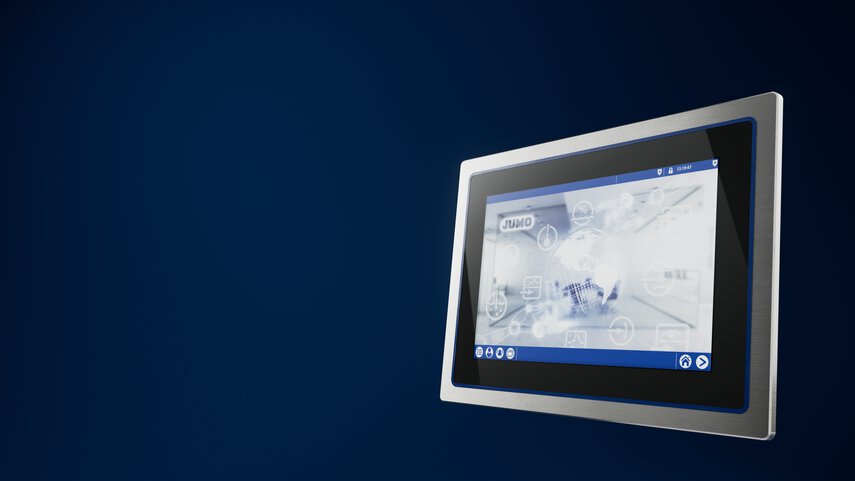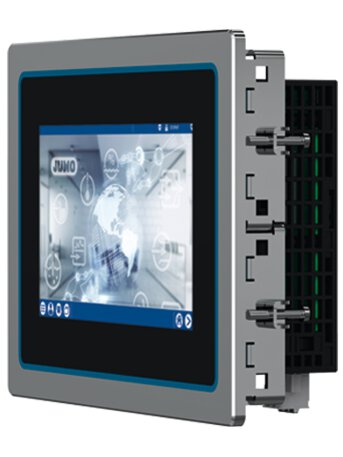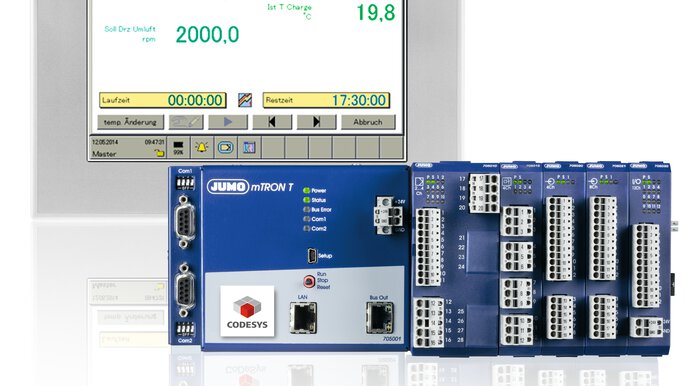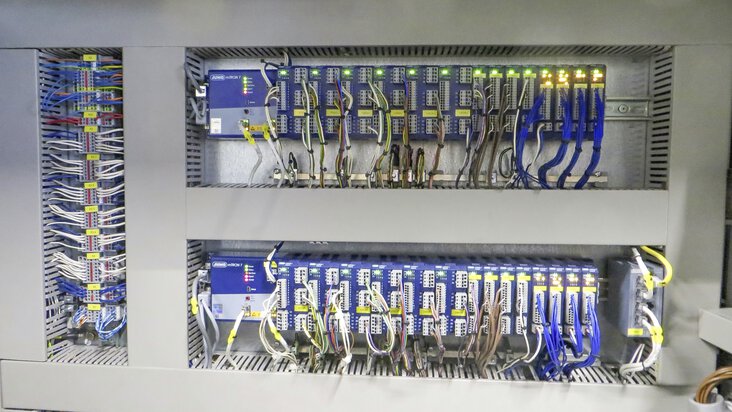

PLC controllers – industrial applications
In today's fast-paced industrial world, automation has become a key element that helps companies increase efficiency, improve safety and reduce costs. At the heart of these automation processes are PLCs (Programmable Logic Controllers), which are the brains behind most modern industrial systems. In this article, we take a look at how these programmable logic controllers work, the benefits of using them, which industries use them, and discuss the different types of PLCs, including the PLC range from JUMO. Check it out!
What is a PLC and how does it work?
A PLC (Programmable Logic Controller) is an electronic device used to control industrial processes. The operating principle of a PLC is based on reading input data from various sensors, processing them according to a programmed algorithm and then generating the appropriate output signals to control machinery and equipment.

The programmable logic controller is used to control the operation of a machine or other industrial equipment. It can also be used to control production lines, lighting or other electrical equipment.
Programmable Logic Controllers - Structure
PLC controllers consist of several basic components:
- Central Processing Unit (CPU): This is the heart of the PLC controller. The main task of the CPU is to execute programs stored in the controller's memory. It processes input data, performs logical or mathematical operations, and generates output data.
- Memory: The PLC controller's memory stores the user's program as well as input and output data. There are various types of memory, such as RAM for storing temporary data, ROM for storing permanent data, and flash memory for storing user programs.
- Input/Output Modules (I/O): Input/output modules are used for the PLC controller's communication with the external environment. Input modules receive signals from sensors and transmit them to the CPU, while output modules receive signals from the CPU and transfer them to executive devices, such as motors, valves, relays, etc.
- Power Module: Like any electronic device, the PLC controller requires a power module for operation. The power supply provides voltage to all components of the controller.
- Communication Interfaces: PLC controllers often come with built-in communication interfaces such as Ethernet, RS232, RS485, PROFINET, EtherCAT, etc., which enable communication with other devices like computers, other PLC controllers, operator panels (HMI), and so on.
- Enclosure: All these components are enclosed in a casing that protects them from external factors like dust, moisture, high temperature, etc.
Depending on the model and manufacturer, a PLC controller may have additional features or components such as built-in touchscreen displays (e.g., JUMO vaRITRON 500 touch), memory card slots, USB ports, etc.

PLCs can have additional functions or components, such as the built-in touchscreen on the JUMO variTRON 500 touch
What are the benefits of using a PLC controller?
Working with PLC controllers offers many advantages, such as:
- Increased efficiency and productivity: The ability to automate control processes enhances performance. They facilitate the execution of repetitive tasks in both simple and complex industrial processes.
- Flexibility: PLC controllers can be easily programmed to control various processes, making them adaptable for diverse applications.
- Error reduction: Automating processes using PLC controllers decreases the risk of human errors.
- Safety: PLC controllers can monitor and regulate industrial processes, thereby enhancing the safety of workers and equipment.
PLC Controllers vs. Relay-Contactor Systems
Furthermore, PLC controllers are characterized by low energy consumption and an exceptionally high level of reliability compared to older systems based on relays and contactors.
They are more advanced than relay-contactor systems, which required physical changes in wiring for alterations in control functions. An advantage of PLC controllers is that we can easily change how they control systems by modifying the controller's program, rather than changing intricate wiring. This results in significant simplification and a reduction in the time associated with modifying the control of a given installation.
By using PLC controllers, you also don't need additional devices like time relays or auxiliary contactors, enabling you to save on equipment and installation costs.

One of the main advantages of working with PLCs is the automation of complex industrial processes
Application of PLC controllers in industry
PLC controllers are widely used in various industrial sectors, such as:
- Facility Engineering: PLC controllers can automatically monitor and control HVAC (Heating, Ventilation, and Air Conditioning) systems, lighting, security systems, and other systems in buildings. For instance, a PLC can be programmed to automatically turn on lights in a building at a specific time of day, control traffic lights, or adjust room temperature based on temperature sensor data.
- Mechanical Engineering: In manufacturing, PLCs can control machinery and devices like presses, milling machines, lathes, industrial robots, etc. For example, a PLC can be programmed to automatically start and stop a machine at the right moments, increasing production efficiency and reducing the risk of errors.
- Measurements and Control: PLCs are used for collecting data from various sensors, such as temperature, pressure, humidity, flow, etc., and then controlling devices based on these data. For instance, in a water management system, a PLC might monitor water levels in a tank using a water level sensor and automatically turn a water pump on or off based on this data.
- Automation: PLCs are a key component in industrial automation systems. They can control an entire production line, coordinating the operation of various machines and devices to ensure a smooth and efficient production process.
- Industrial Furnace Construction: PLCs can monitor and control processes in industrial furnaces, such as temperature, pressure, gas flow, etc. For example, a PLC can automatically adjust gas supply to a furnace based on temperature sensor data, ensuring optimal furnace efficiency and safety.
- Food, Pharmaceutical, Medical, and Biotechnological Industry: PLCs can control production and packaging processes, such as ingredient mixing, pasteurization, sterilization, bottle filling, labeling, etc. For instance, in the food industry, a PLC can be programmed to automatically add the correct amount of ingredients to a mix based on a recipe.
- Power and Water Supply: PLCs can monitor and control energy and water distribution systems, such as transformer stations, distribution networks, pumping stations, etc. For instance, in an energy distribution system, a PLC might monitor the network load and automatically switch power sources as needed, ensuring continuous power supply.
- Water and Environmental Technologies: PLCs are essential in monitoring and controlling water treatment and waste management systems. For instance, they might control processes like coagulation, sedimentation, filtration, and disinfection at a water treatment plant. In waste management systems, PLCs can control processes such as sorting, composting, incineration, and waste storage.
In each of these cases, the application of PLC controllers in industrial automation contributes to increased efficiency, enhanced safety, cost reduction, and error minimization. This translates to improved performance and competitiveness for businesses.

One of the applications of PLCs is the construction of industrial furnaces and the control of their operation
Types of PLC controllers
There are several basic types of PLC controllers available on the market:
Compact PLCs
These are small, single-module devices that have all the elements of a PLC controller integrated, i.e., the central unit (CPU), memory, communication interfaces, and input/output modules. Due to their size and cost, they are ideal for simple or moderately complex automation tasks.
Example: The compact PLC JUMO variTRON 300 is such a device. This central unit can function as a receiver for the wireless JUMO wTrans sensors.
Modular PLCs
These are more complex devices consisting of separate modules (CPU, input/output modules, communication interfaces, etc.) that can be freely configured. This gives them great flexibility and allows them to be adapted to the user's specific needs. They are typically used in more intricate automation systems.
Example: JUMO variTRON 500 serves as an example. It's a central unit with a PLC controller according to IEC 61131-3 (CODESYS V3.5) combined with proven input and output modules.
Rack PLCs
These are the most advanced and efficient PLC controllers, typically mounted in cabinets and consisting of a series of modules mounted in racks (or chassis). They can handle large numbers of inputs/outputs and are frequently used in large industrial systems requiring substantial computational power and intricate control logic.
Soft PLCs
These are PLC controllers that run on a standard PC or industrial PC, using special software to simulate the operation of a traditional PLC. Soft PLCs offer many of the advantages of traditional PLCs, such as flexibility and efficiency, while also providing increased capabilities, such as easy integration with other computer systems.
Remember, choosing the right PLC controller depends on various factors, such as function requirements, the number of inputs/outputs, communication requirements, and more. When selecting a PLC controller, it's a good idea to consult with an experienced supplier, like JUMO, who can assist you in picking the right solution for your specific application.
JUMO PLC Controllers - Buy a PLC Controller
- JUMO variTRON 300: This is a compact system controller. The central unit can function as a receiver for the wireless JUMO wTrans sensors. The router module can be used to connect dedicated JUMO input and output modules and to configure the entire PLC system (CODESYS V3.5).
- JUMO variTRON 500: This is a central unit with a PLC controller according to IEC 61131-3 (CODESYS V3.5), combined with proven input and output modules. It forms a complete automation system based on the JUMO JUPITER platform. Modern communication interfaces (OPC UA server, MQTT) and PROFINET IO, EtherCAT Master, Ethernet, RS232/RS485. Possibility to connect 64 additional modules. Available with 256 control loops.
- JUMO variTRON 500 touch: This is a programmable logic controller with an integrated touchscreen. Equipped with a colorful TFT screen, touchscreen in 7" and 10.1" versions. Displays in different formats (portrait or landscape, 4:3 or 16:9) can be connected; CODESYS TargetVisu, CODESYS Remote TargetVisu, or CODESYS WebVisu. Optionally, PLC according to IEC 61131-3 (CODESYS V3.5), as well as Node-RED. It has a powerful processor with a quad-core 800 MHz.
- JUMO mTRON: The central unit of the JUMO mTRON T automation system. Freely programmable PLC controller according to IEC 61131-3 (CODESYS V3.5). Simple configuration of connected input and output modules.
Using PLC controllers can significantly improve production, increase efficiency and safety, and reduce the risk of errors. That's why they are indispensable in many industrial sectors.

JUMO mTRON T PLC central processing unit and modules
Summary - what are the benefits of using PLCs?
PLCs play a key role in modern industrial automation, enabling companies to increase efficiency, improve safety and reduce costs. Thanks to their flexibility and ability to control a variety of processes, PLCs have found their way into a wide range of industrial sectors, from plant engineering to the food industry to energy and water supply.
The JUMO range, including the JUMO variTRON 300, JUMO variTRON 500 and JUMO variTRON 500 touch, MTRON demonstrates how diverse and versatile these devices can be. Whether you need a compact controller for simple applications or an advanced system with the possibility of connecting additional modules, JUMO has something to meet your requirements.
In the era of digitalisation and Industry 4.0, PLCs are not only essential, they are the key to the future of industry. Therefore, it is worth understanding how they work and how they can contribute to the success of your business.
- ${title}${badge}

